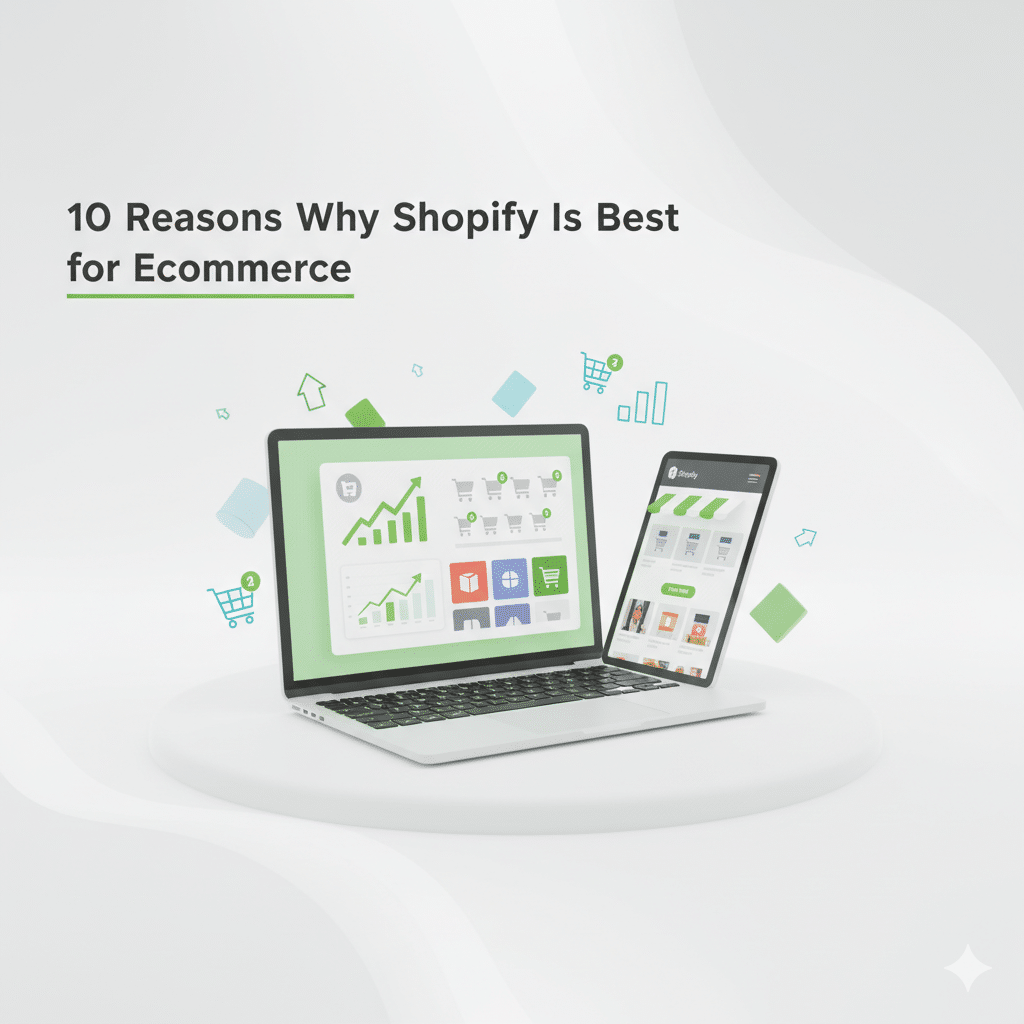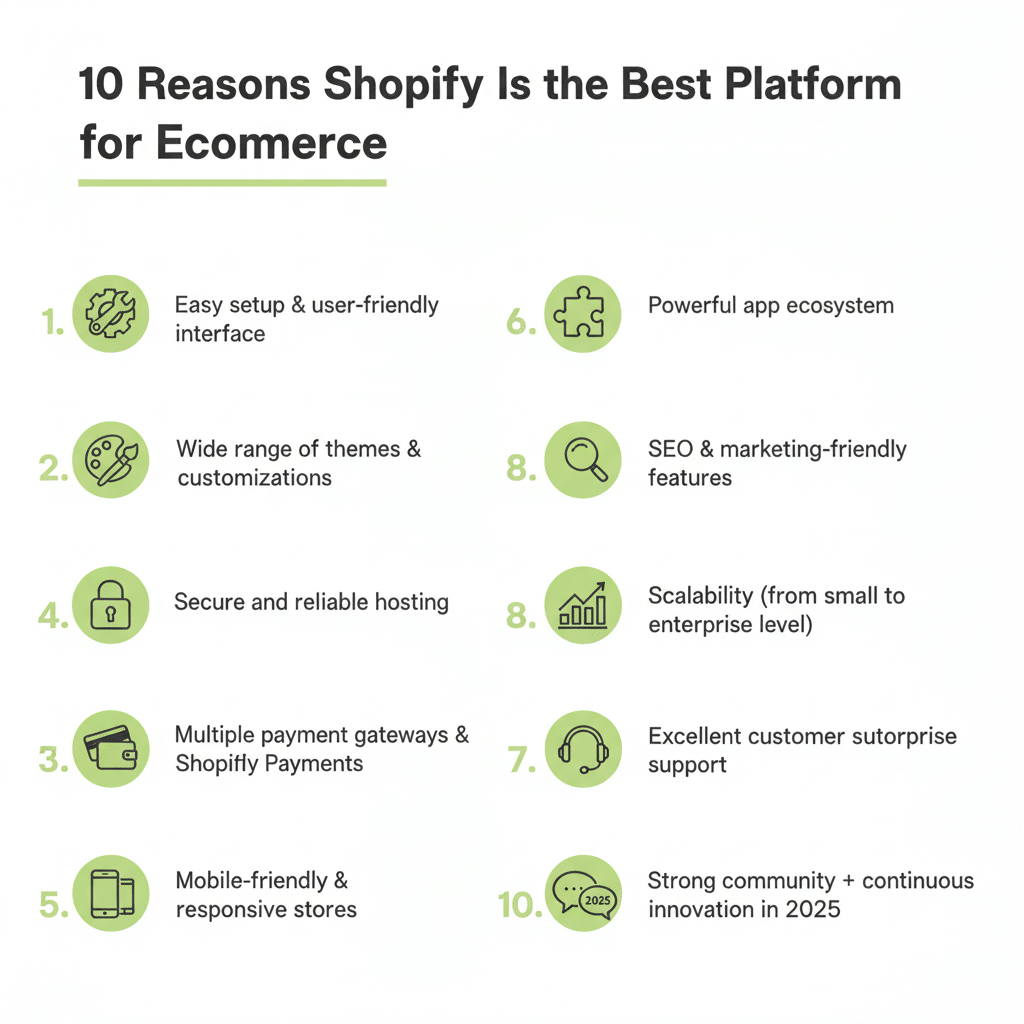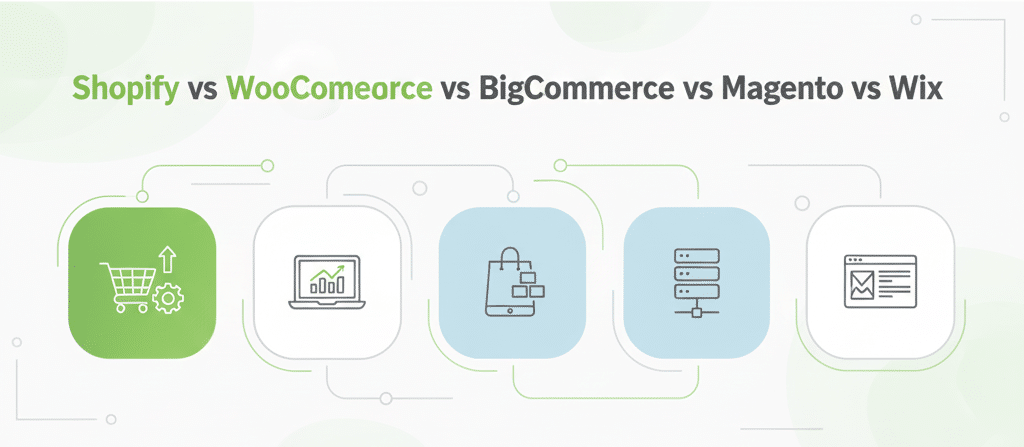

When you’re planning an online store, choosing the right engine can make or break your launch. Shopify stands out for its sheer scale — by 2025 it supports about 4.82 million active storefronts worldwide. That kind of adoption hints at reliability and trust, two essentials when real money and real customers are involved.
But it’s not just the numbers. Merchants crave a platform that moves fast, handles payments and stock cleanly, and plays well with marketing tools. On top of that, the global ecommerce market is expected to hit roughly $4.8 trillion in 2025.
In this post, we’ll walk you through ten solid reasons why Shopify often comes out on top for online commerce. Whether you’re launching your first venture or scaling a longer-term business, you’ll get a clear look at what Shopify delivers and what that means for your store.

Launching an online store often feels technical and time-consuming. Shopify removes that pain. The setup is clean, guided, and quick, no coding or server work. You sign up, pick a theme, add your products, and your store is ready in hours, not weeks.
The dashboard is built for clarity. Anyone can track orders, manage stock, or tweak designs without needing a developer. This simplicity is the main reason why Shopify is best for ecommerce for beginners and small teams.
If you’ve ever spent days figuring out WordPress plugins or manual hosting, you’ll notice the difference instantly. Shopify lets you focus on selling, not on fixing technical issues.
Your store design speaks before your words do. Shopify offers a big collection of themes made for every kind of business. Whether it’s clothes, gadgets, or local crafts, there is a theme that fits right away.
You can edit colors, layout, and menus without touching any code. It feels like moving blocks, not solving puzzles. If you want more control, developers can still fine-tune using the Liquid editor.
Compared to other platforms, setup is smoother and faster. That is one big reason people rate Shopify vs other ecommerce platforms in Shopify’s favor. It keeps design simple while giving enough room to stand out.
Running an online store means dealing with traffic spikes, customer data, and payments. Shopify takes care of all that quietly in the background. Your site stays online even when sales jump.
Why it helps you:
Many platforms need extra plugins or hosting accounts. Shopify skips that mess and keeps your site fast and safe. This is a clear Shopify ecommerce advantage for anyone who wants stability without hiring a tech team.
When it comes to payments, flexibility matters. Customers expect options, and Shopify gives plenty. It supports 100+ payment gateways including PayPal, Stripe, Amazon Pay, and local wallets.
Key highlights:
With this, you spend less time on manual payment setup and more time selling. It’s one big benefit of Shopify for online store owners who want a ready-to-use system without complex integrations.
More than 70% of online shoppers buy using mobile devices. Shopify themes are built to load fast and display neatly on any screen. You don’t need separate designs for desktop and mobile.
Why this matters:
If you are wondering is Shopify good for beginners, this is proof. You focus on products while Shopify ensures your store looks good everywhere.
Shopify’s app store is like a toolbox for your business. There are thousands of apps for marketing, reviews, shipping, analytics, and customer service. You can add or remove them anytime without affecting your main site.
What this means for you:
It gives real control without heavy coding. Many merchants say this wide Shopify features 2025 lineup helps them grow faster and test ideas quickly.
Having a good-looking store is not enough. People must find it. Shopify takes care of that part too.
Built-in advantages:
Even if you are new to digital marketing, Shopify helps you appear in search results and social feeds. These tools make it easier to reach buyers and improve visibility, one of the biggest Shopify ecommerce advantages for small brands.
Shopify grows with you. Start with a small plan and upgrade as your business expands. You don’t need to migrate or rebuild your store.
Key strengths:
This level of flexibility makes it one of the best ecommerce platform 2026 options for both startups and enterprises. Whether you sell ten products or ten thousand, the experience stays smooth.
When things go wrong, quick help matters more than any feature. Shopify’s support team is available day and night through chat, email, and phone. Their guides and help center are simple to follow and actually useful.
Many new sellers feel stuck during setup or payments. Getting a real answer within minutes makes a huge difference. You don’t waste time searching through online forums or outdated YouTube videos.
Good support also builds confidence. You know someone is there if an order fails or a plugin breaks. That peace of mind alone justifies the plan cost. For most users, this is one of the biggest Shopify pros and cons discussions that ends in Shopify’s favor.
Shopify’s strength isn’t only its software but also its people. The global community of developers, designers, and store owners keeps sharing new ideas, tutorials, and ready-made templates. You can find real solutions from people who have faced the same issues.
The platform keeps evolving too. In 2025, Shopify added new AI-assisted tools, faster checkout options, and improved analytics dashboards. These updates arrive automatically, so you stay current without technical effort.
This mix of a growing community and steady upgrades shows Shopify scalability in real life. It adapts to changing online trends while keeping things simple for sellers who just want to grow their business.

| Aspect | Shopify | WooCommerce (WordPress) | BigCommerce | Magento / Adobe Commerce | Wix |
| Platform type | Hosted SaaS. Shopify handles hosting, security, and updates. | Self-hosted plugin for WordPress. You pick hosting and manage updates | Hosted SaaS with built-in features and enterprise tier. | Two options: Magento Open Source (self-hosted) and Adobe Commerce (licensed enterprise cloud or on-prem). Higher complexity. | Hosted site builder with ecommerce plans. Easy start, limited deep customization. |
| Pricing (starting plans) | Starts at $29/month (Basic) billed yearly. Trial available. Transaction fees vary by plan and gateway. | Core plugin free. Main costs are hosting, domain, premium themes, and paid extensions. Hosting often $20+/month for good hosts | Standard $39/mo, Plus $105/mo, Pro $399/mo. Enterprise custom pricing | Magento Open Source is free but hosting and development cost extra. Adobe Commerce licensing often starts high for enterprise budgets (tens of thousands per year). | Ecommerce plans from $29/month (Core) to $159/month (Business Elite) for yearly billing. Free tier exists for non-ecommerce sites. |
| Setup & ease of use | Very easy. Guided setup and a clear dashboard. Good for non-technical users. | Moderate. Requires WordPress setup and hosting. More steps and more choices. | Moderate. More built-in features than Shopify, but setup can be heavier for complex stores. | Harder. Needs experienced developers for setup and maintenance, especially for Adobe Commerce. | Very easy. Drag and drop editor. Good if you want quick results with low effort. |
| Hosting & performance | Included. Cloud hosting tuned for stores and traffic spikes. | Depends on chosen host. Performance varies by host and plan. | Included. Focus on store performance and scaling. | Self-hosted or managed cloud. Performance depends on infra and dev work. | Included. General hosting for sites and stores. |
| Themes & design | Many free and paid themes. Mobile-ready. Editor for non-coders. | Huge theme market via WordPress but theme quality varies. | Good theme options and built-in layout tools. | Themes exist but custom front ends are common. High design control for dev teams. | Large template library focused on visuals. Easy drag and drop. |
| Apps / extensions | Large app store for marketing, shipping, subscriptions, reviews. Easy to add features. | Massive plugin library via WordPress. Many free and paid plugins. Plugin conflicts possible. | Built-in features plus app marketplace. Fewer third-party plugins than WooCommerce. | Strong extension ecosystem for Adobe Commerce and Magento Open Source. Many enterprise modules. | Wix App Market for extra features. Smaller than Shopify and WooCommerce in scope. |
| Payment options & fees | Many gateways. Shopify Payments removes extra transaction fees and simplifies setup. Third-party gateway fees apply if not using Shopify Payments. | Supports many gateways via plugins. Gateway fees charged by processors. No platform payment fee from WooCommerce itself. | Supports many gateways. No platform transaction fee on some plans. | Supports many gateways through extensions. Setup usually requires dev work. | Built-in payments plus common gateways. Easy setup. |
| SEO & marketing tools | Good built-in SEO, sitemaps, and easy ad integration. Apps add advanced marketing. | Strong SEO via WordPress tools and plugins. High control for content and blogs. | Good built-in SEO features. Strong integration with marketplaces. | Very flexible SEO and marketing for custom setups. Requires dev input. | Basic SEO features are included. Simple for small stores and local businesses. |
| Security & compliance | PCI compliant, SSL included, automatic updates and security patches. | Security depends on host, theme, and plugins. You must manage updates and patches. | PCI compliant, SSL, managed security in hosted plans. | Security depends on setup. Adobe issues critical patches sometimes; needs active maintenance. | SSL included and managed. Wix handles security updates. |
| Customization & developer control | Good for standard stores. Theme code and APIs let devs extend features. | Highest control. Full WordPress and PHP access for devs. | High custom options and APIs for complex stores. | Maximum control. Best for large, custom needs. Heavy dev work. | Limited developer options compared to open platforms. Wix Velo offers dev tools but not full like WooCommerce or Magento. |
| Maintenance & support | Shopify handles platform maintenance. 24/7 support. | You handle updates, security, and backups unless you get managed hosting. Support depends on host. | Support included with plans. Enterprise support for large accounts. | Adobe Commerce customers get enterprise support. Open source needs community or paid support. | Wix support and managed platform. Good for non-technical owners. |
| Scalability | Scales from small stores to enterprise with Shopify Plus. Easy plan upgrades. | Can scale but often needs better hosting and dev ops as volume grows. | Built to scale; Pro and Enterprise tiers target large sellers. | Scales for big sellers but costs and complexity rise fast. | Scales up to a point. Best for small to medium stores. |
| Best for | Sellers who want a fast, reliable, hosted store and less tech work. | Content-led stores, blogs, and stores that need full control. | Growing merchants that want built-in features and scale. | Large retailers or brands that need deep customization and have dev teams. | Small sellers, service businesses, and owners who want quick setup. |
| Notes / tips | Good to test with free trial. Consider payment plan and app needs when budgeting. | Budget for reliable hosting and a small dev or maintenance plan. | Check Pro limits and price breaks tied to sales volume. | If you pick Adobe Commerce, request a custom quote and plan for ongoing patches. | Use Wix if you want speed and low overhead. For bigger stores, compare features closely. |
Here are two detailed case studies of well-known brands using Shopify, showing what they achieved and how the platform helped them.
Challenge: Gymshark was operating on a different commerce platform when a major sales event (Black Friday) caused the site to crash. They lost an estimated £100 000 during the outage and recognised the need for a more robust system.
Solution: The brand migrated to Shopify Plus, enabling scalable infrastructure, faster checkout customisations via Shopify Scripts and tighter integration of online and offline channels (via POS) to handle global growth.
Results: After replatforming, Gymshark hit £41 million in sales in 2017, grew a social following of 5.1 million across 131 countries, and built a global brand identity—all while using Shopify as the foundation.
Key takeaway: For brands needing both scale and speed of innovation, Shopify allowed Gymshark to move fast and handle traffic spikes without repeated platform failures.
Challenge: Allbirds had grown rapidly and opened retail locations, but managing inventory across online and in-store sales was inefficient. Many online orders missed out because stock in stores wasn’t available to fulfill web orders.
Solution: Using Shopify POS and the “Ship from Store” feature, Allbirds unified online and offline inventory. They made their 31+ retail stores part of the fulfilment network, reduced returns and warehouse shipping costs, and broadened the assortments available online.
Results: The brand improved website conversion rates (thanks to more live inventory), reduced labour & shipping expense from returns, and supported seamless omnichannel shopping. The result: higher sales efficiency and stronger customer experience.
Key takeaway: For businesses with both physical and online presence, Shopify can unify channels and reduce friction in fulfilment and stock management.
1. The clear winner
Shopify stays ahead because it makes selling online simple, fast, and secure. From small startups to global brands, it scales without extra technical stress.
2. Practical next step
Start with the free trial, test checkout speed, and list a few products. Learn the basics before spending on ads.
3. Need help building or customizing?
At Stellites, we work with digital agencies and business owners to design, build, and manage Shopify stores that convert better. Whether you need full setup, custom themes, or long-term support, our Shopify developers can help you grow faster with less effort.
Schedule a Call and Get a 7-Day Free Trial
No Credit Card Required
Schedule a Call and Get a 7-Day Free Trial
No Credit Card Required
What’s Included in the Trial:
✓7 days of work across six key technologies
✓Access to premium tools needed for your projects
✓No questions asked if you choose not to continue afterward
✓Transparent communication with daily progress updates
✓Fast turnaround to help you meet tight deadlines
✓ Opportunity to test our workflow and collaboration process firsthand
Stellites partners with digital agencies as a white-label provider for their talent and development needs. We offer top-tier professionals in Digital Marketing, SEO, Paid Advertising, as well as WordPress, Shopify, and other platforms—available on a full-time or pay-as-you-go basis.
At Stellites, our white-label development services are designed to deliver 100% pixel-perfect and technically complex projects within competitive timelines, allowing your agency to scale effortlessly and impress your clients.
Stellites partners with digital agencies as a white-label provider for their talent and development needs. We offer top-tier professionals in Digital Marketing, SEO, Paid Advertising, as well as WordPress, Shopify, and other platforms – available on a full-time or pay-as-you-go basis.
At Stellites, our white-label development services are designed to deliver 100% pixel-perfect and technically complex projects within competitive timelines, allowing your agency to scale effortlessly and impress your clients.
COPYRIGHT © 2025 Stellites Technologies. All Rights Reserved.
Get 15% Discount on all product
Enter your email to receive your exclusive coupon and start saving on your next purchase. Don’t miss out on special deals and updates!
[contact-form-7 id="702acf5" title="Get Coupon Code"]